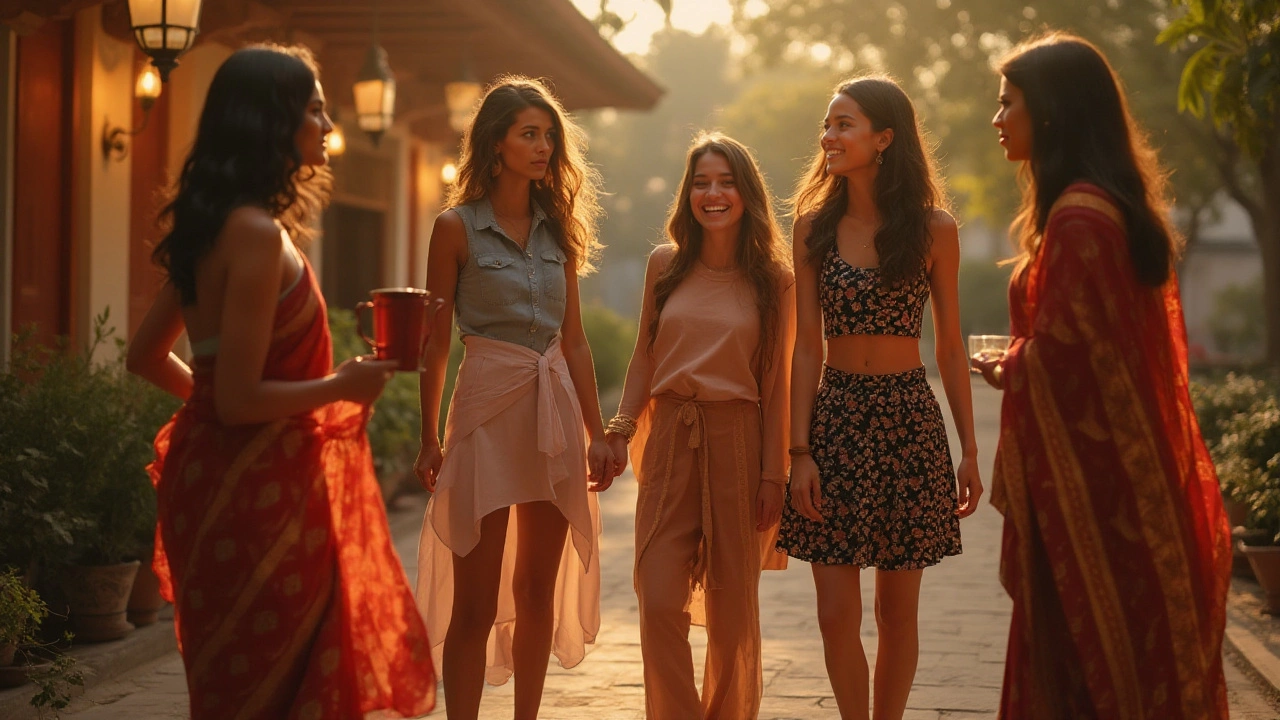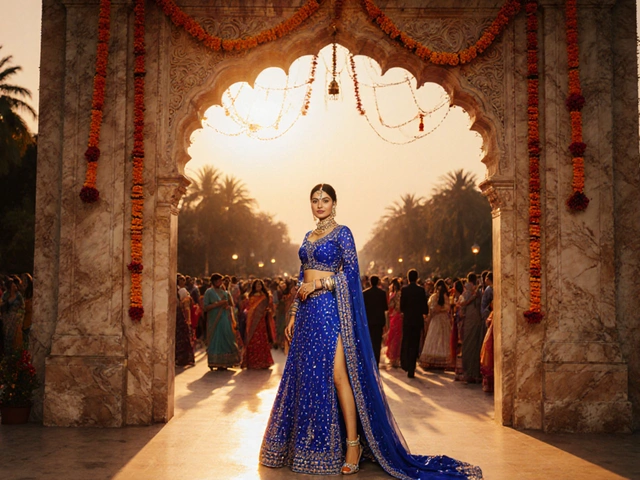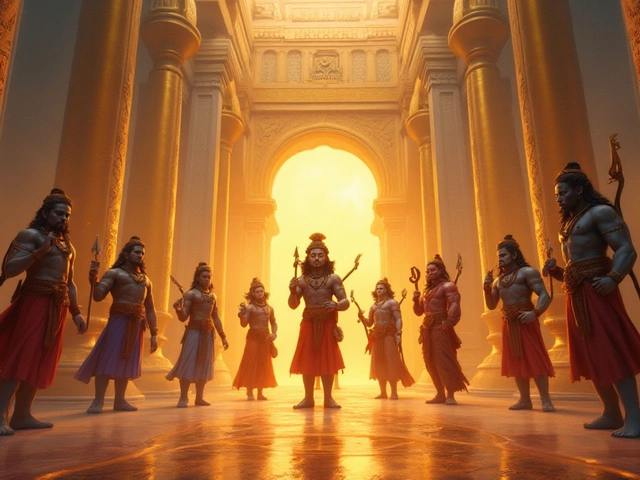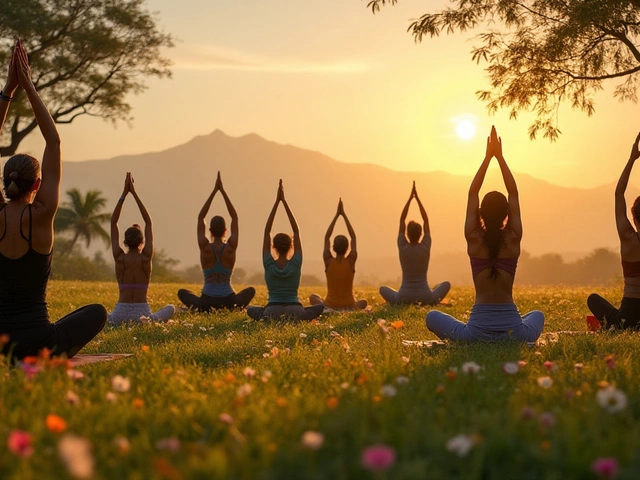When considering the choice of wearing a mini skirt in India, it's essential to recognize the nuances woven into its social and cultural fabric. The nation stands as a mosaic of traditions, each thread offering a unique perspective on fashion.
India's dress code has historically been influenced by its diverse cultures, each endorsing its own style while respecting myriad customs. However, today's fashion embrace showcases a splendid fusion of these ancient traditions with contemporary trends.
For those contemplating donning a mini skirt, understanding regional variations becomes key. Metropolitan areas often exhibit a liberal approach, while smaller towns may hold conservative views.
From the bustling streets of Mumbai to the artisanal heartland of Jaipur, the fashion landscape offers surprising contrasts. Yet, at the heart of it all, lies an evolving style ethos—one where tradition gracefully intertwines with modernity.
- Historical and Cultural Context
- Regional Variations and Social Norms
- Fashion Trends and Urban Influence
- Practical Tips for Wearing Mini Skirts
- Modern Indian Designers Embracing Change
Historical and Cultural Context
The sartorial journey of Indian clothing is as rich and diverse as its history. From the ancient drapes worn by the Indus Valley civilization to the intricately woven silks of the Mughal era, each period has left an indelible mark on the fashion landscape. Historically, traditional attire such as saris and dhotis carried a deep cultural significance, reflecting not only the climate and geography but also societal norms and local craftsmanship. As India evolved, so did its fashion practices, with each era importing new styles and materials that were deftly woven into the cultural tapestry.
The arrival of British colonial powers and subsequent exposure to Western clothing revolutionized Indian fashion in the late 19th and early 20th centuries. Women's clothing began to incorporate blouses and petticoats, layering traditional aesthetics with Western silhouettes. While mini skirts feature prominently in modern urban wardrobes, they are a relatively late arrival in the Indian style narrative. Despite initial resistance from conservative quarters, mini skirts have gradually carved out a niche within the larger fashion ecosystem, especially within India's bustling urbanites. An expert from the 20th-century cultural historian Ritu Kumar encapsulates the cultural shift:
"Modern fashion in India cannot be seen without acknowledging its hybrid nature. What fascinates me is how the youth embrace these transformations while still honoring their heritage."
Yet, the deeper layers of India's clothing history reveal a myriad of influences beyond British influence. The Mughal era, renowned for its opulence, brought with it luxurious silks and decorative motifs, influencing everything from everyday garments to regal attire. Trade routes introduced vibrant hues and fabrics like cotton, which found their way to Europe and back, not only as commodities but as elements of exchangeable culture. Over time, regional differences in textiles and dressing styles developed, with northern salwar kameez differing markedly from the southern veshti, reflecting the country's incredible diversity.
Understanding this historical and cultural context sets the stage for appreciating the aesthetic adaptive nature of Indian fashion. The question of whether one can wear a mini skirt in India is layered with cultural perceptions and historical precedents. While the mini skirt might symbolize modernity in cities such as Mumbai and Delhi, it's crucial to remember the traditional roots that define much of the country. Consider how each garment threads its story through the cultural context it inhabits, allowing for a unique acceptance and adaptation of global fashion trends. Hence, though mini skirts stand as one strand in the fashion mosaic, they also echo tales of a society continually balancing its past with its ever-evolving style narrative. In a 2023 survey, it was revealed that 45% of urban young adults in India felt comfortable incorporating Western attire into their daily wear, underlining the growing fusion of styles.
Regional Variations and Social Norms
India, a land of contrasts and diversity, reflects this rich tapestry in its attitudes towards clothing, particularly something as contemporary as a mini skirt. These attitudes are as varied as the languages spoken across the different states. In bustling metropolitan cities like Mumbai and Bangalore, where the young workforce fuels a cosmopolitan lifestyle, dressing in western attire, including mini skirts, is quite common. These cities are often seen as melting pots where traditional Indian clothing and modern fashion seamlessly coexist. In such urban environments, the fashion forward mindset is palpable, allowing for an acceptance of diverse sartorial choices.
However, the situation in smaller towns and rural areas paints a different picture. Fashion norms here lean towards the conservative side, with traditional attire like sarees and salwar kameez being the norm. In such places, a woman stepping out in a mini skirt might attract attention or even disapproval. The social fabric in these regions is closely knit with community values playing a significant role in influencing dress codes. What one wears can often be perceived as a reflection of one's respect for cultural values and traditions.
"India's strength lies in its diversity, but this also means understanding the vast pool of social norms that govern one's attire," says renowned sociologist Dr. Meera Kumar.
Even within states, there's diversity in attitudes. In West Bengal, for instance, the capital city Kolkata, known for its intellectual bent, is more liberal fashion-wise compared to its suburban districts. Similarly, Goa, known for its tourist-friendly beaches, showcases a liberal approach with tourists and locals seen wearing a variety of western clothing, including mini skirts. This freedom stands in stark contrast to states like Uttar Pradesh, where traditional values often guide public attire choices. Yet, even in these traditional centers, the younger generation, influenced by social media and pop culture, is beginning to challenge the status quo, nudging the fashion boundaries ever slightly.
Interestingly, fashion in India is also influenced by religious practices and events. Hindu festivals like Diwali might see a rise in traditional dressing, whereas casual outings or affairs may embrace more relaxed western clothing. The religious diversity across the country adds layers to fashion choices, as each community brings its distinct culture into the mix. It’s noteworthy that within India, while variations in dress codes are largely influenced by region, age, religion, and socio-economic status also play a vital role in shaping these norms.

Fashion Trends and Urban Influence
The evolution of fashion trends in India, particularly in urban areas, tells a fascinating story of change and adaptation. Over the last few decades, Indian cities like Mumbai, Delhi, and Bangalore have emerged as melting pots of global trends, each with their own unique flavor. The influence of Western fashion has been profound, shaping the street style and couture scenes alike. The mini skirt in India has become a symbol of this amalgamation of cultures. As the younger generation embraces new styles, there is a palpable sense of fashion liberation in the air. The rise of the mini skirt in cities often mirrors the growing confidence and individuality of modern Indians. Yet, this is held in balance with the respect for the country's glorious sartorial heritage.
Urban areas have a delightful way of fostering experimentation. The cosmopolitan environments create fertile grounds for fashion-forward ideas. Social media has further accelerated this trend by flattening horizons; trends from Milan to Mumbai are instantly accessible, inspiring the youth to express themselves creatively. This has fostered unique style fusions, where traditional Indian elements are skillfully incorporated into Western silhouettes like the mini skirt. Such hybrid styles are not only found on the streets but also on runways and in high-street brands. Ultimately, the cityscapes of India serve as both canvases and catwalks. This narrative of the urban influence on fashion is constantly evolving, with designers and individuals alike pushing the boundaries of what is conventional.
Despite this rapid evolution, social considerations remain influential. Urban areas tend to be more open to avant-garde fashion statements, but they are not devoid of their own sets of norms and expectations. In some circles, traditional attire still holds sway during festive and formal occasions. Nonetheless, the growing acceptance of diverse dress styles signifies a broader cultural shift. This is not just about aesthetics; it is also about celebrating diversity and personal expression. Discussions about style often become conversations about empowerment and identity. The fashion landscape in Indian cities is as varied as its populace. As people migrate from different parts of the country, they bring with them a rich tapestry of cultures, which contributes to the vibrant blend of traditional and contemporary styles.
Fashion's urban influence in India is increasingly mirrored in the local media. From fashion weeks that draw attention to emerging designers to cinema and television series showcasing contemporary wardrobes, the engagement with modern trends is omnipresent. Magazines and online platforms play a pivotal role in presenting fashion in India as cutting-edge and inclusive. Often, they highlight how designers are reimagining traditional textiles like silk and cotton into modern outfits, including mini skirts. Such media narratives not only boost awareness of fashion opportunities but also empower designers to continue blending worlds and pushing creative boundaries. As they gain traction in global markets, Indian fashion pioneers advocate for this duality—being rooted yet free to explore.
Tensions do exist between traditional purism and modern eclecticism, yet they symbolize a healthy dialogue. The growing parallel conversations around sustainable fashion further complicates this landscape. Both indie labels and established brands are beginning to adopt eco-friendly practices, showing that the future of fashion in India could be both stylish and responsible. This reflects a broader sensitivity, a recognition that fashion must balance not only heritage and modernity but also consumer demand and environmental concerns. It's a dynamic and sometimes dizzying world, where every mini skirt tells a story of change, choice, and culture. The dance between traditional and modern is, in essence, a celebratory one. Indeed, it is the cities—these pulsating beacons of innovation—that are transforming the fabric of fashion in India.
Practical Tips for Wearing Mini Skirts
Delving into the vibrant streets of India while wearing a mini skirt might seem like an adventure waiting to happen. Yet, it requires a bit of thoughtful consideration to align fashion with respect for local customs. In India, styles can vary drastically from one region to another, reflecting its rich tapestry of cultures. Thus, being aware of the setting is essential. In cosmopolitan cities like Mumbai and Delhi, you might find an eclectic mix of traditional and modern wear, where mini skirts have found their place among the younger crowd seeking to express individuality.
Yet, journey a few miles into the rural delights, and you'll notice a stark difference. Here, traditional Indian clothing, such as the saree or salwar kameez, often prevail as common attire. In these areas, wearing a mini skirt might attract undue attention, not out of indignation, but sheer curiosity. Here’s a helpful tip: pair your mini skirt with a modest top or a scarf, which can offer an effective balance between contemporary style and cultural adherence, ensuring comfort and respect abiding in every step.
Now, let’s talk material. India’s diverse climate warrants thoughtful clothing choices. In the tropical southern states, lightweight and breathable fabrics can help you stay comfortable. Meanwhile, the cooler northern regions might require layering with tights or stockings to stay warm and stylish. Fashion in India is as flexible as its people, allowing individuals to tailor outfits for both comfort and style while keeping an eye on tradition.
"Fashion is about more than just style; it’s a reflection of where we come from and where we’re going," remarked Indian designer Manish Malhotra, highlighting the blend of global and traditional influences.
Consider traveling with a fashion buddy: versatility. A flowy wrap or shawl fits snugly into any bag and can serve multiple purposes—whether you’re covering up for modesty in a temple or wrapping around on a chilly evening. This adaptability proves that wearing a mini skirt in India is not just about the garment but the styling choices you pair with it.
Safety is paramount, naturally. Large crowds or unfamiliar areas may call for a different approach. Tourist hotspots like Goa or Jaipur are usually more comfortable zones for wearing revealing clothes due to their exposure to international tourists. But it's always worthwhile to listen to locals' advice or observe what cultures around you are adhering to. On your Indian adventure, following these simple guidelines can help you blend comfort with fashion, ensuring that your experience remains pleasurable and filled with delightful memories.

Modern Indian Designers Embracing Change
In the vibrant tapestry of India’s fashion scene, modern designers play a transformative role, boldly merging the traditional with the contemporary. These visionaries are not merely creating clothes; they are crafting stories that speak to a generation seeking both authenticity and innovation. This dynamic cohort is essential in progressing the dialogue around fashion items such as the mini skirt in India. In recent years, a new wave of designers is challenging the status quo, pushing the boundaries of style while staying rooted in cultural ethos. Designers like Sabyasachi Mukherjee and Manish Malhotra are known for their deep reverence for traditional craftsmanship, yet their collections frequently include pieces that reflect a global sensibility. This juxtaposition offers a refreshing take on what Indian fashion can represent.
There's a notable trend among these design luminaries to incorporate silhouettes like the mini skirt into their collections, reinterpreting them with Indian textiles and motifs. This creative fusion not only garners attention domestically but also positions India as a critical player on the global fashion map. An example is the innovative work of Masaba Gupta, whose designs blend playful prints with classic Indian textiles, creating pieces that resonate with India's youth while affirming cultural identity. In an interview, she commented,
“The future of Indian fashion lies in our ability to bridge our glorious past with the promise of today’s trends."Such a mindset illustrates the unique balance of heritage and contemporary design.
The increasing acceptance of fashion in India that includes shorter hemlines signifies a broader social acceptance and a move towards gender neutrality. These designs do not exist in a vacuum; they reflect changing societal norms where urban centers like Delhi and Bangalore become more accepting of global trends. As these modern creators continue to gain respect and clientele both regionally and internationally, their work serves a dual purpose—celebrating Indian culture while simultaneously advocating for progression and change. Noteworthy is the rise of eco-conscious and sustainable practices in the fashion industry, another area where Indian designers lead. The table below shows an interesting insight into the current landscape:
| Designer | Eco-conscious Material | Annual Growth (%) |
|---|---|---|
| Ritu Kumar | Handwoven Khadi | 12% |
| Anita Dongre | Sustainable Cotton | 9% |
| Rahul Mishra | Organic Silk | 10% |
This table provides a snapshot of the growing emphasis on sustainability embraced by top designers, aligning with global concerns about environmental welfare. As more Indian designers gain platform, there's an increased potential for India to influence worldwide fashion trends positively. The journey of these creative experts is a testament to India's evolving identity where tradition and modernity coexist harmoniously. They continue to pave the way for a fashion future that is inclusive, sustainable, and profoundly inspiring.





